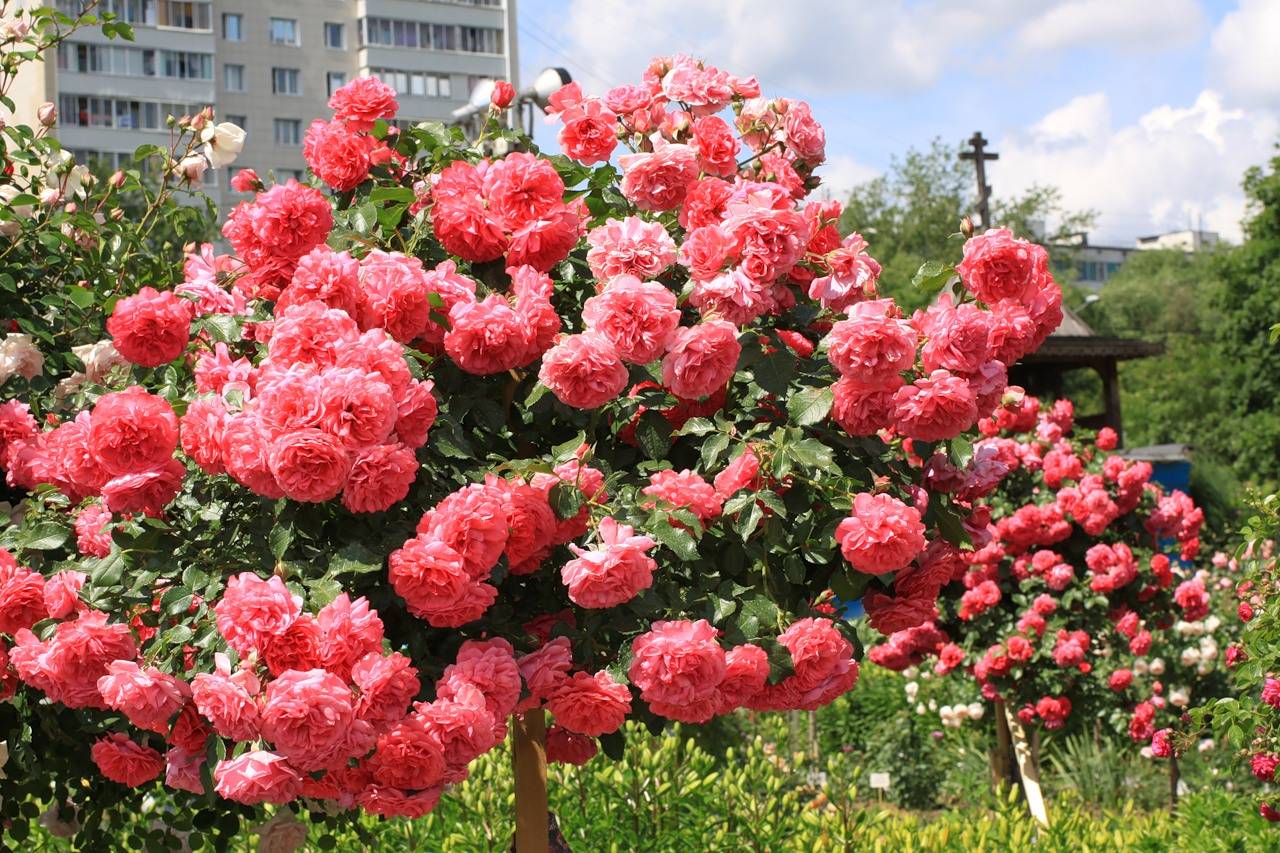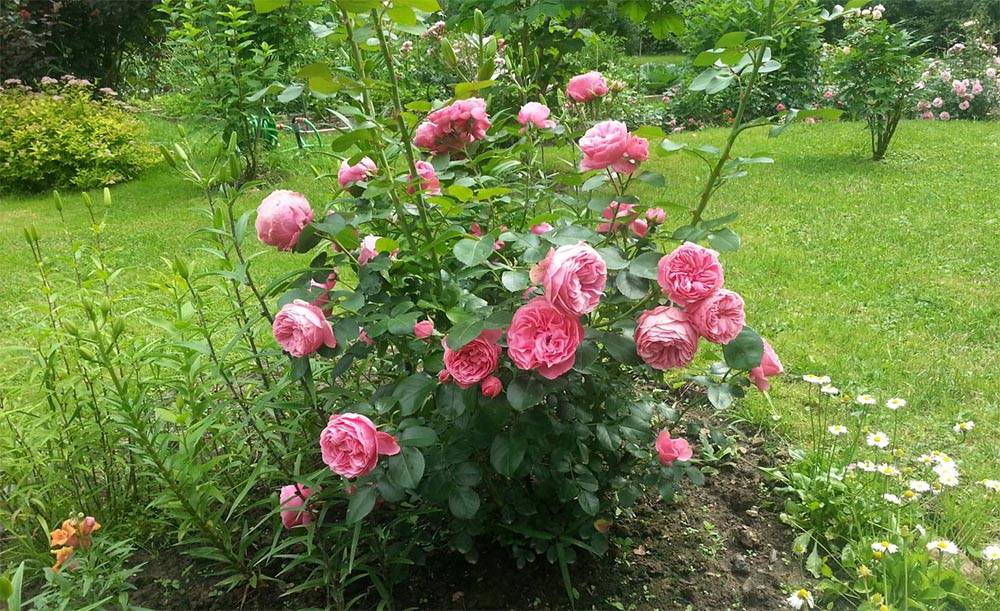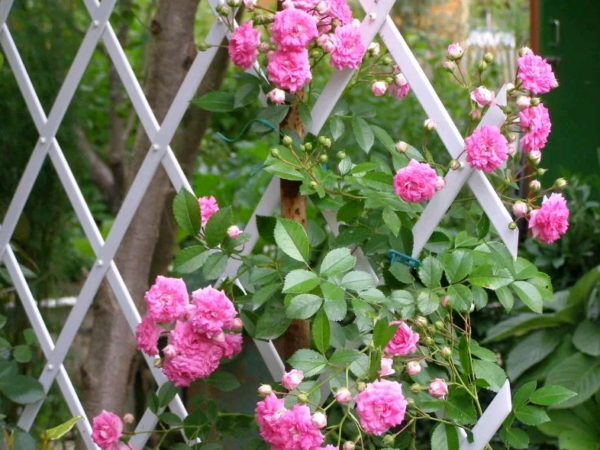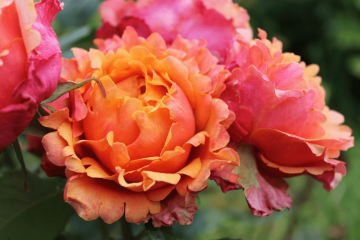Rose Super Dorothy (Super Dorothy) - what kind of re-flowering variety
Content:
Climbing roses blooming from June to October will be a great decoration for any garden or summer cottage. Super Dorothy is a luscious, hot pink rose. Beautiful lush inflorescences grow on its shoots.
Rose Super Dorothy (Super Dorothy) - what kind of variety
Rose Super Dorothy is very popular with flower growers. Climbing roses, to which this variety belongs, have long shoots (2-3 m) and loose inflorescences with large flowers. The thorns on the branches are almost invisible.
The predecessor of Super Dorothy was the rose Dorothy Perkins. It was improved by the breeder K. Hentzel (Germany) in 1986. The result of his work were roses of a bright and rich color, capable of blooming for a very long time. The external feature of the new colors is that a white speck can be seen in their core.
Brief description and characteristics
Each branch of the Super Dorothy rose has 25-40 buds. Pompom-type flowers bloom from them: many small petals are tightly pressed against each other. Each flower can grow up to 4–5 cm in diameter. The petals can be colored pink in any shade: from delicate and light to dark, almost lilac tones. In the middle of the flower, paler petals form a white spot. In the bright sun, the flowers turn pale. Super Dorothy has a sweet vanilla aroma and fills the garden with its scent.
Many shoots up to 3 m long grow from a tall, spreading bush. They have dark green leaves with a shiny smooth surface. The bush grows rapidly in width and takes up a space of about 3-4 m². It is advisable to fix soft twigs on a support (trellis or trunk). You can only tie them with nylon thread so as not to injure the branches. Many growers do not hang pink shoots from supports, but allow the bush to grow and become a ground cover plant.
Super Dorothy roses are not afraid of diseases such as powdery mildew and black spot. This variety is highly frost-resistant: under cover it can withstand temperatures down to -25 ° C. In a warm southern climate, these flowers do not need to be covered for the winter.
Advantages and disadvantages of the variety
Reading the description of this variety, its most important advantages and disadvantages are immediately visible. Super Dorothy has many advantages over other rose varieties:
- tolerates long rainy weather well;
- strong immunity against many diseases;
- blooms for a long time (June-October) and withstands the first frosts;
- young flowers are constantly replaced by faded ones;
- frost resistance;
- unpretentious, so an inexperienced florist can grow it.
Disadvantages:
- blooming, the bud often loses its rich color and turns pale.But thanks to the large number of buds in the inflorescence, this is almost impossible to notice;
- in cold northern climates, the flower needs winter shelter.
Use in landscape design
Like many other ground cover roses, Super Dorothy is used extensively in landscaping. It is grown in rose gardens and greenhouses. Super Dorothy roses decorate verandas, walls of houses, buildings, gazebos. The delicate beauty and delicate aroma of these flowers create a cozy romantic atmosphere in the garden and at home.
Growing a flower
Climbing rose Super Dorothy takes root well in the open field and grows. It is necessary to prepare a suitable place for her on the site and choose good seedlings.
You can grow a Super Dorothy rose from a strong healthy seedling, which has 3-4 strong shoots. The root system must be well developed.
The best time to plant Super Dorothy is in the spring - April or May. At this time of the year, seedlings take root and grow actively.
Seat selection
For a beautiful and capricious rose, you need a sunny area, reliably protected from wind and drafts. To protect the land from the appearance of weeds, you can cover the place for the rose with mulch. A plot mulched with pine bark, needles, fallen leaves or fresh cut grass looks very beautiful.
If the gardener plans to grow a rose on a support, it is necessary to prepare it in advance. An arch, trellis, bole, pergola and even an ordinary fence are ideal.
How to prepare the soil and flower for planting
Before planting in open ground, the roots must be cut by one third, and then put in a jar of water in which the growth stimulator is dissolved. After 4–5 hours, it can be transplanted into open ground.
You need to dig a hole in the ground 50 cm deep and 60–70 cm in diameter. Peat, humus and sand must be added to the soil extracted from the hole, and then mixed. Mixing ratio 2: 1: 1: 1:
- land - 2 parts;
- peat - 1 part;
- humus - 1 part;
- sand - 1 part.
After that, 200 g of ash is added to the soil, which will lower the acidity level of the soil. Then this earthen mixture is fertilized: you need 300 g of special fertilizer for roses. The finished primer can be put on a sheet of paper or plywood.
Planting procedure step by step
In order for the sprout to take root and grow to the size of a bush, it is necessary to strictly follow the rules for planting and caring for it.
How to plant a Super Dorothy rose sapling:
- A pre-treated seedling is placed in a hole. It should stand in the middle at a slight slope.
- The roots are carefully covered with prepared soil.
- The root collar should be underground at a depth of 9–10 cm.
- The soil is lightly tamped and then watered.
Plant care
In the first year of life, a young rose needs good care, then after a while it will bloom. The plant must be properly watered, fed, cut.
Watering rules and humidity
The rose is watered abundantly once a week. The water must first be defended within a day. Before watering, it should warm up to room temperature. The flower should be watered at the root only after sunset. The soil must be mulched after each watering. This will retain moisture for a long time.
Climbing roses love high humidity. This weather is usually set at the end of August, so at this time Super Dorothy blooms especially brightly and luxuriously.
Top dressing and soil quality
Fertile clay soil with good drainage is ideal for growing Super Dorothy. The soil near the roots must be regularly loosened and weeds removed.
The first feeding will be needed a year after planting. In early spring, it is necessary to remove the winter shelter and immediately feed the rose with nitrogenous fertilizers. Then you should wait 2 weeks and water the soil with a solution of bird droppings or mullein.
After buds begin to form on the branches, nitrogen fertilizers can no longer be applied. During the flowering period, the rose is fed once every 14 days. You need to use a mineral mixture of potassium, phosphorus, magnesium.
At the end of August, the last feeding of the year is carried out, during which superphosphate is applied.
Pruning and replanting
You need to cut the branches of a climbing rose so that they grow quickly. In addition, with the help of garden shears, you can give the bush a beautiful and unusual shape.
Pruning shears or scissors must be sharpened and disinfected to prevent infection from entering the plant. Shoots are cut off 5 mm above the bud, cutting at an angle. Dried and damaged branches must be removed completely at the root. If a branch is frozen in winter, then during the first spring pruning, its frozen part is removed to the level of living tissues.
There are several ways to trim:
- lightweight. Healthy shoots are shortened by two-thirds. Carry out no more than 1 time in 4–5 years;
- moderate. Cut off the top half of a healthy branch;
- strong. Healthy branches are cut to the third or fourth bud so that sprouts 12-15 cm high remain.
Three cuts are carried out during the year:
- frozen, dead and damaged branches are removed in spring. Older branches should be heavily pruned and younger branches should be pruned moderately;
- in the summer, wilted buds and too thin herbaceous twigs are removed. Above every third or fourth bud, you need to pinch the stem. Additionally, young growth around the bush is removed;
- in the fall, discolored branches are cut off, the stem is cleaned of leaves.
Features of wintering a flower
During a harsh winter, the rose must be covered. Shoots are removed from the support and neatly laid on pre-prepared spruce branches, straw, slate or wooden boards. It is advisable to use spruce branches, because it perfectly retains heat and allows the plant to breathe. The branches of a rose bush are folded into a ring or a spiral. You can straighten them in length. On top of the branches, you need to put a non-woven fabric rolled in several layers. After that, you need to huddle the bush, raising it 30–40 cm higher.
Blooming rose
You can endlessly look at blooming roses. But at this time, the flower needs to be well looked after.
A period of activity and rest
Super Dorothy roses bloom from early summer to late fall. Flowers are constantly renewed: old ones bloom and fall off, young buds open.
Care during and after flowering
A blooming rose needs regular feeding. Every 2 weeks she is fed with mineral fertilizer.
Faded buds must be removed from the bush. Weak stems are also cut off: inflorescences will not appear on them. After the rose bush has faded, all the leaves are cut off from it and the branches that have not faded are cut off.
What to do if it does not bloom
If the rose has not bloomed, you need to find out the reason. This happens if the bushes are planted too close to each other or they grow on insufficiently fertile soil.In these cases, the flower is transplanted into more nutritious soil.
The buds do not bloom if the plant is overfed with nitrogenous fertilizer. Then it puts all its strength on the growth of new branches, and not on the buds and flowers.
Flower propagation
Ready-made seedlings can be bought at the store. If Super Dorothy is already growing in the flowerbed, you can propagate the flower from the mother bush. There are two known methods of propagation of climbing roses: cuttings and layering.
In June or early July, you can propagate the rose by cuttings. Layers can be made at any time during the flowering period.
Propagation by cuttings:
- A branch that has just bloomed is cut from the bush. It is cut into pieces 10–12 cm long.
- It is necessary to prepare the beds in advance in the same way as when planting a seedling.
- Cuttings must be placed in these holes so that the surface of the earth reaches the middle of each of them.
- The beds are covered with plastic wrap. In such a shelter, cuttings can survive two winters.
- In the third year, full-fledged seedlings will grow, which need to be transplanted to a permanent flower bed.
Reproduction by layering:
- A small narrow ditch is dug near the flowering bush, a lateral branch is taken there and sprinkled with earth in 3-4 places along its entire length. Secure these spots with a wooden peg or nylon string.
- The diverted escape is covered for the winter and waited until spring. Then this branch is cut from the mother bush and planted separately.
Diseases, pests and ways to control them
Super Dorothy is not susceptible to many common flower diseases, but it is frequently affected by pests.
How to deal with diseases and parasites:
- green aphid. The bush is treated with aktellik, aktara, alatar;
- spider mite. The bush is poured with a stream of water from a hose, then Aktofit, Acrex, isophene preparations are used;
- slobbering penny. It is necessary to press down with your fingers all the places covered with foam, then apply the means of alatars, the spark of the commander, aktar;
- thrips, leafworm, leafhopper, scale insect. The universal drug "Rose Rescuer" will help against them
- gray rot, spotting. Pure flowers are used against them (three times with a break of 20 days).
For the prevention of diseases, the plant is treated with the Rose Rescuer in the first warm days of spring, then in early June, and then in the last days of July.
Brown spots on the leaves are a sign of a fire blight. Branches affected by burns must be cut off.
Incredibly beautiful climbing roses will decorate any, even the most nondescript piece of land. Even a novice florist can grow the Super Dorothy variety. Much attention needs to be paid to supporting and pruning this plant.




























